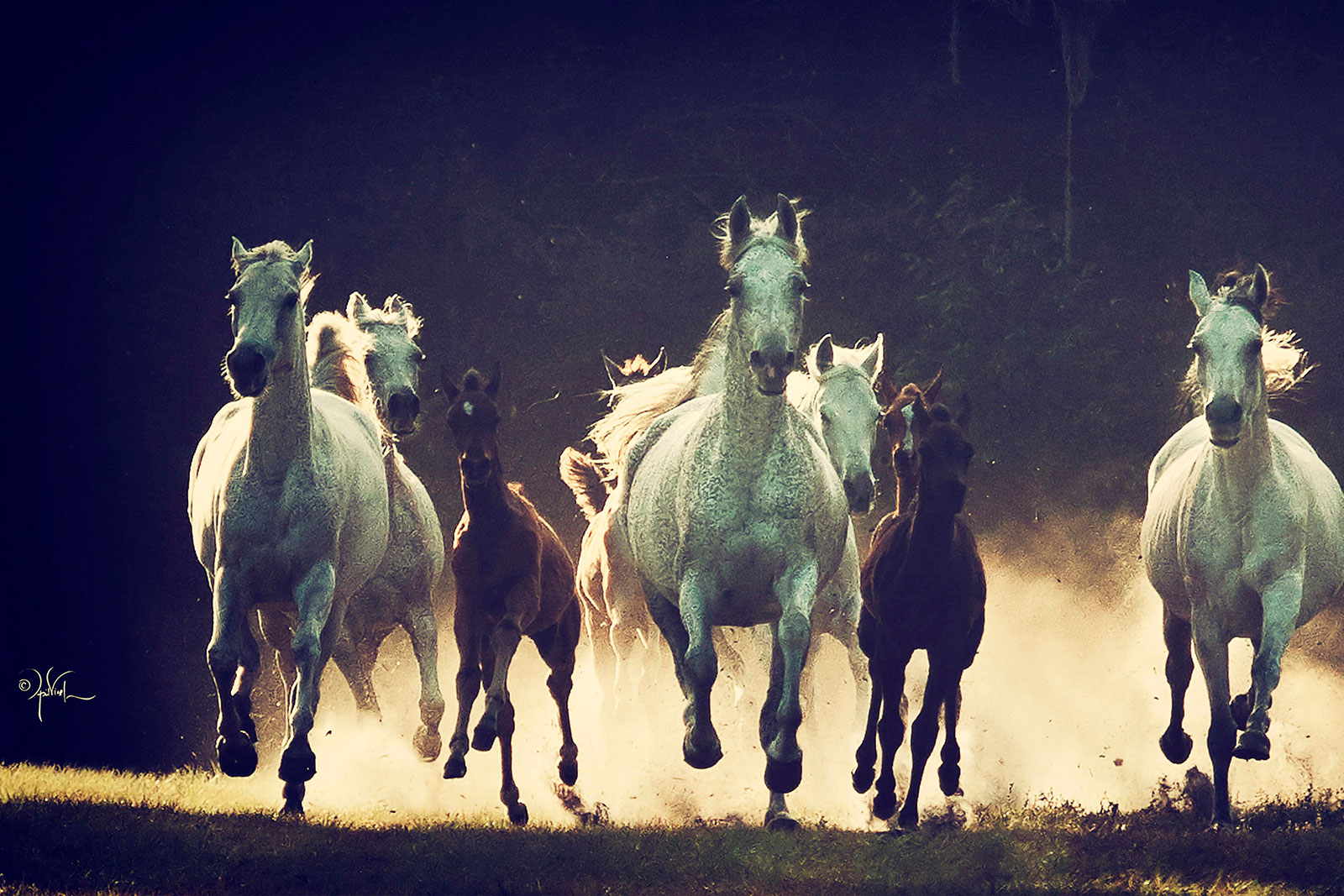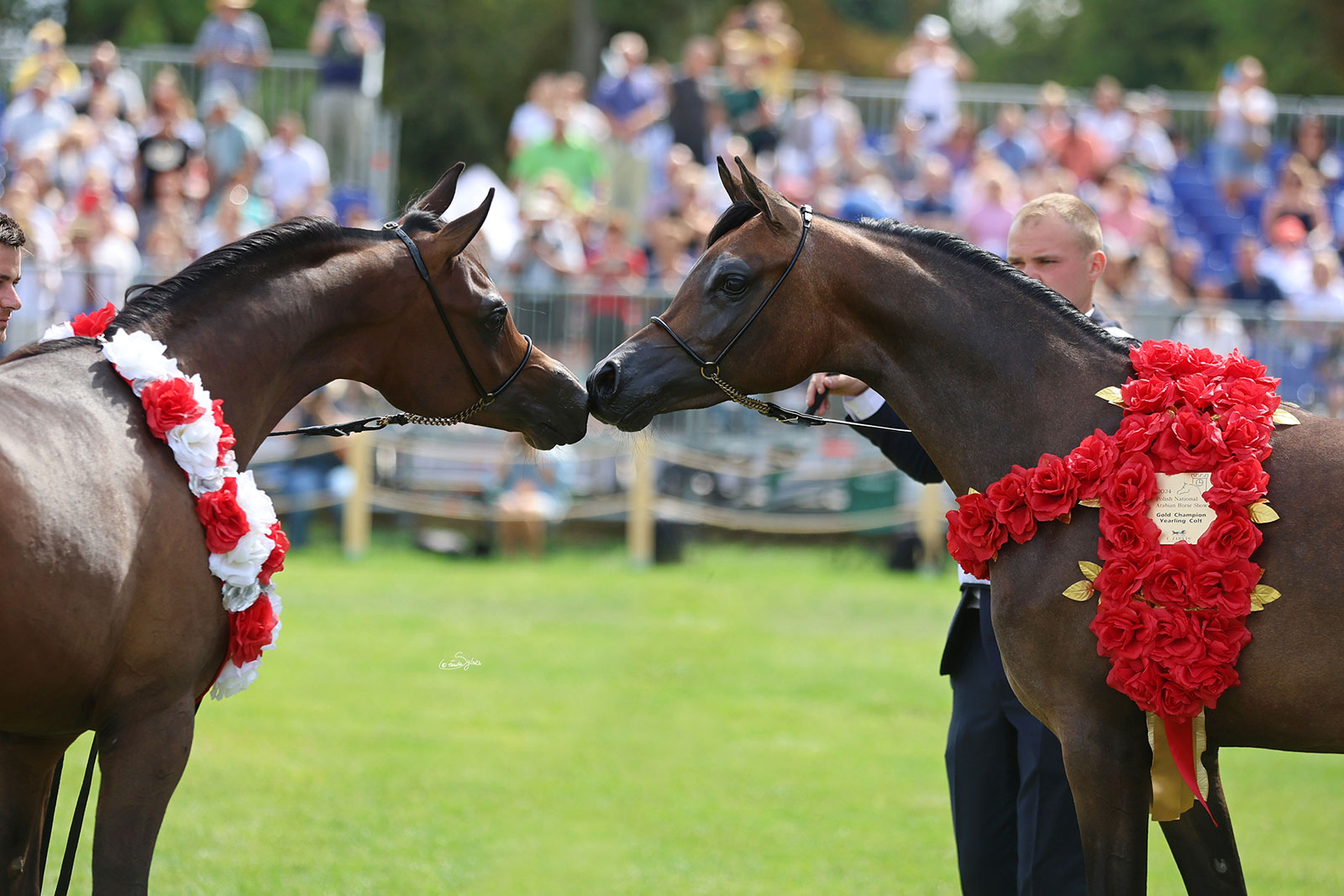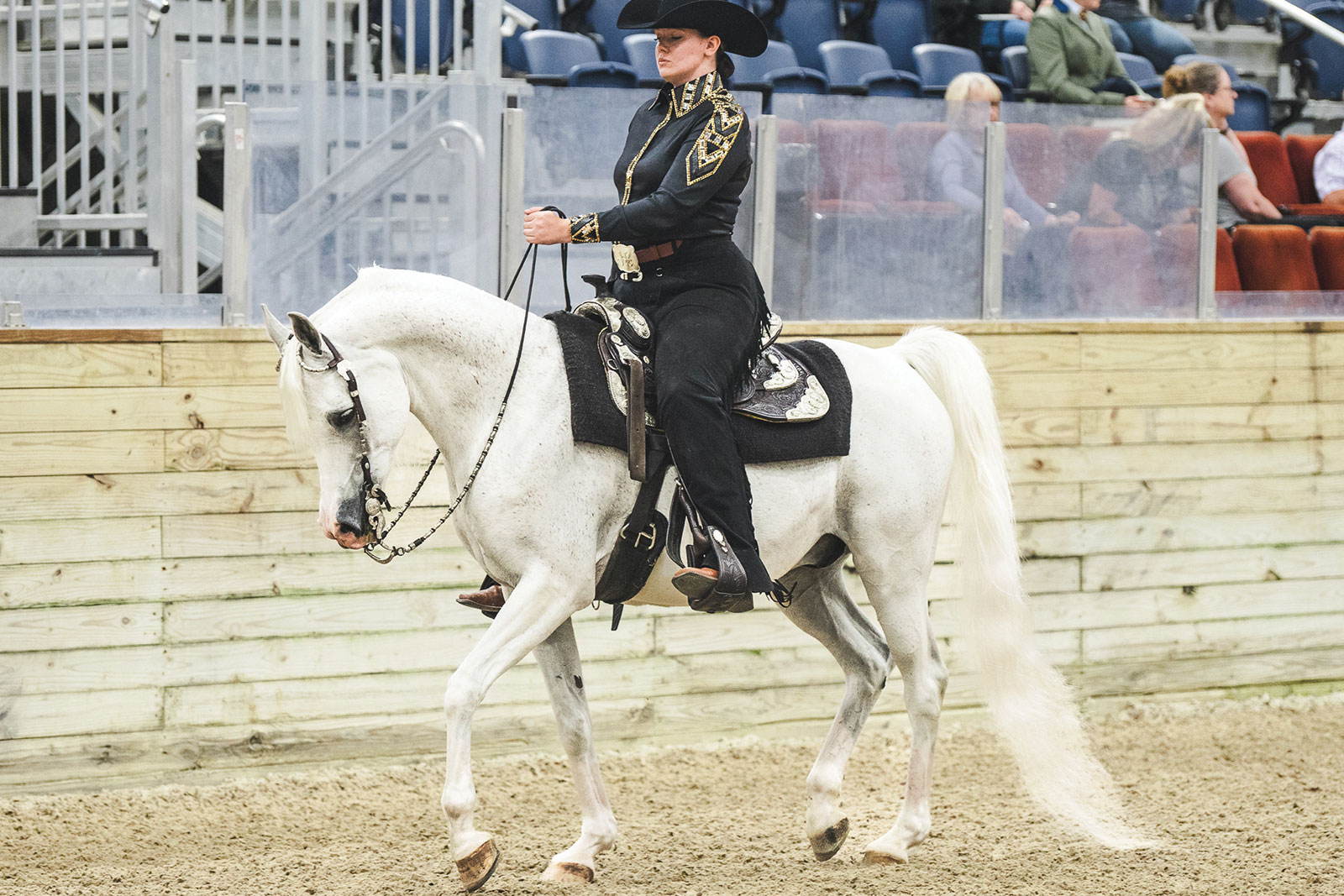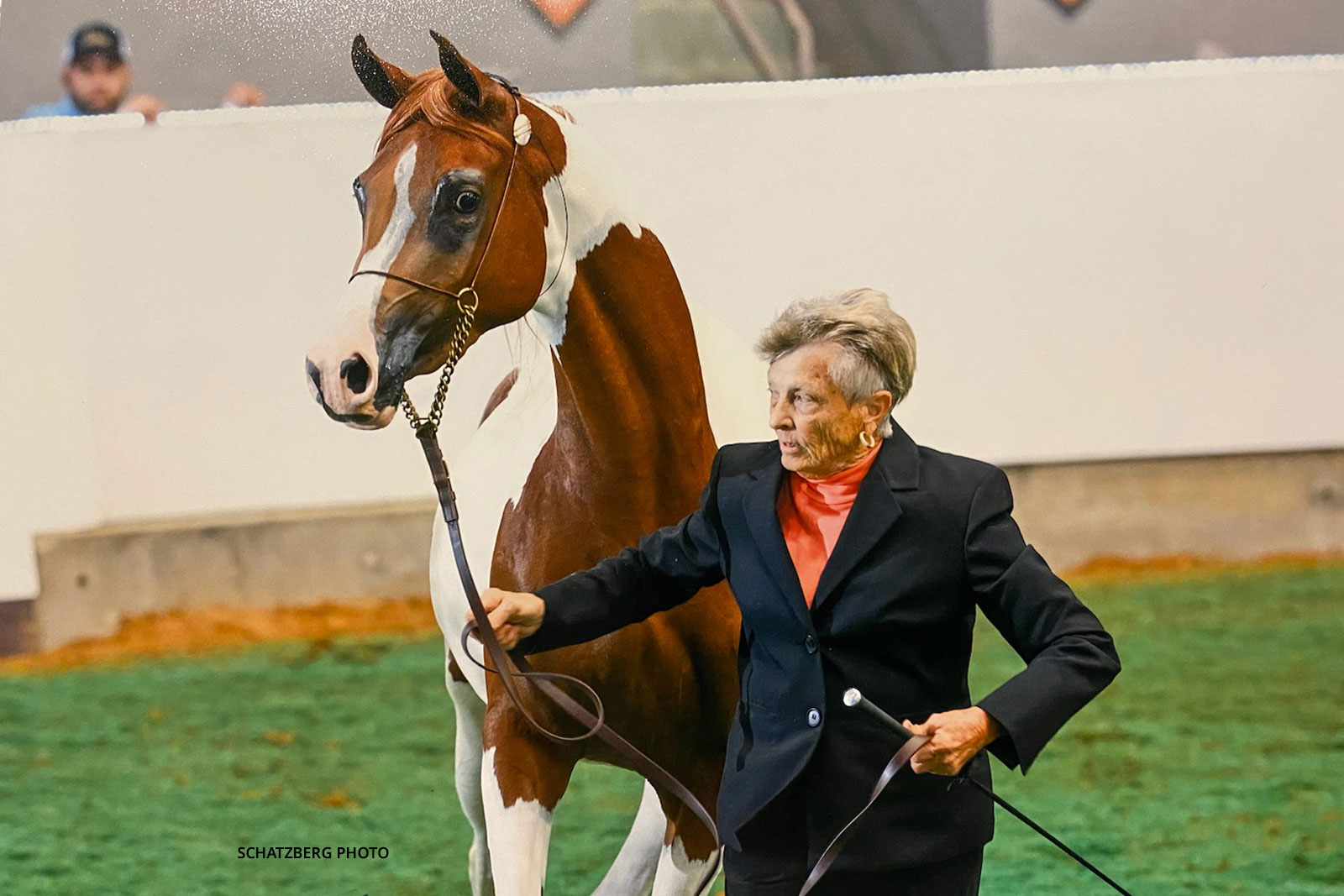By Cindy Reich
As featured in the August 2008 Issue of Arabian Horse World.
August is a brutal month for heat in most of the northern hemisphere. It is also a busy month on many fronts. Second or third cuttings of hay are generally being harvested. Horses are eating down the grass that remains in paddocks in more arid places. Foals are being weaned and show horses are being primed for the autumn shows.
This is a tale of two farms and two ways of doing things in the dog days of August. By the way, the expression “dog days of August,” referring to the extreme heat of that time of the year, referred not to real dogs panting in the sun, but the “dog star” Sirius. Sirius is in the Canis Major constellation, which is prominent in the sky in July and August. At this time, Sirius is the brightest star in the sky and usually rises just before or just as the sun rises. The Greeks thought that Sirius could influence the behavior of dogs and in the intense heat, made dogs go mad.
Farm Smith and Farm Jones are in the same part of the Midwest, where the days are hot and humid, and the nights not much better. Farm Smith keeps the mares and foals out day and night in large pastures with large shade trees and three-sided shelters. Farm Jones also has large pastures with trees and sheds, but they keep the mares and foals in stalls at night and outside during the day. At night, the stalls have fans. It is weaning time, and some of the early foals are old enough to be vaccinated for the first time. In general, foals should be vaccinated around five to six months of age, as their own immune system is well developed by this time and can respond well to the vaccines. The majority of vaccines for foals recommended by the AAEP (American Association of Equine Practitioners) start at four months of age at the earliest, in most cases.
So far, things have been going well. On the Smith farm, the foals are halter broken soon after birth and the foals are led with the mares to and from the barn when they need to leave the pastures. The Jones farm does not halter break their foals until weaning. When the mares and foals come in each evening, the foals follow their mothers — for the most part. When they don’t follow, they are hazed through the gates by grooms forming human “fences” to get the foals into the stalls. A disadvantage to this practice is that as the foals get older, they get more independent and don’t always want to follow their mother. It takes additional time and personnel to get them where they need to be as the season progresses.
It is mid-August, and both farms have decided to start weaning foals. On the Smith farm, the weaning is starting with the oldest foals. As all of the mares and foals live outside together, weaning begins when the mothers of the oldest two foals are quietly removed from the pasture while the foals are all together playing. The mares are taken to a fi eld together on the far side of the farm, where they cannot see or hear the foals. Eventually, the foals go looking for their mothers. They call for a little while and run around the other mares, but as all the other mares and foals are relaxed, the foals quiet down quickly and resume grazing and playing. At fi ve months old, they no longer require their mother’s milk for nutrition — they nurse for “comfort.” There is a creep feeder in the middle of the pasture where the foals are supplemented but the mares are not. Both mares and foals are in excellent condition under this protocol. Nothing else is done with the foals at this time.
At the Jones farm, weaning has started as well. Two foals at a time are put into a stall and their mothers taken to a field on the far side of the farm where the foals can’t see or hear their mothers. Halters are put on the foals with a trailing lead, and they are vaccinated for several diseases and given a dewormer. The foals circle the stall, calling for their mothers. When approached, they try to push past the groom and get out of the stall. They continue this behavior for several days. Meanwhile, the foals’ mothers run the fence line calling and looking for their foals. They have each other for company, and after a few days they settle down and start to graze. The foals are kept in the stalls so that they can be halter broken. There are fans in the stall for ventilation.
Within a few days, the foals at the Jones farm started coughing and showing signs of respiratory disease. They had a discharge from the nose, were coughing and generally depressed. There could be many factors infl uencing their coughing. Because the stall doors have solid bottoms and bars on the top half, there is no air circulation at ground level where the foals are eating and living. They are old enough that their heads are above the half level of the door, but still spend a great deal of the day with their heads down. The fan helps to circulate air around the stall. At this stage, the foals aren’t showing any signs of having diarrhea, and their temperature is slightly elevated at 102° (normal temperature for a foal is 101-102°). Given the extreme heat of the day and the humidity, it is a good sign that the foals’ temperatures are not higher.
As the days went by, the mares at the Smith farm were periodically removed from the mare and foal pasture and relocated to the mare pasture. They would call and run the fence for a few minutes, then begin grazing with the mares they had been with previously. Often, the foals wouldn’t even make a fuss when their mothers disappeared. They were in their familiar environment with their buddies and everything was calm and harmonious. Approximately two weeks after each foal was weaned, a team would go out to the foal pasture, catch the foal and give it one or two injections and deworm it. Every few weeks, the weaned foal would get another vaccination until it had been vaccinated for all of the diseases in the farm’s protocol. Since the foal had been halter-broken and led since birth, it was well accustomed to being handled and led and was not a problem to handle. Like the Jones farm, there was a creep feeder in the center of the pasture and the foals were growing quickly and putting on weight.
The Jones foals on the other hand, were not doing as well. They were depressed, not eating well, and their hair coats were dull. They were being halter-broken and learning how to be handled. Sometimes there were some pretty good fights, but the grooms were calm and gentle with them. However, even though they no longer called out for their mothers, when they were taken out of the stall to work on leading, they fought and called and tried to get back to the stall. Their buddy in the stall also ran in circles, calling out for its missing stall mate. Although there was no definitive diagnosis of a specific disease for the Jones foals, they continued to cough and have respiratory problems. Two foals, in separate stalls, were put on medication as their coughing had become quite severe.
In six weeks, the majority of foals on both farms were weaned. On the Smith farm, the foals grazed in contentment in their pasture. Two geriatric mares now grazed with them, as “granny” mares. They supervised the foals and also continued to teach them manners on how to behave around other horses. There had been no coughing, no respiratory problems, no vet bills. The weather was improving and the worst of the heat was hopefully over. In a few months, the colts and fillies will be separated, each into a pasture with a granny mare. They will continue to live outside and come in only when the weather is severe.
On the Jones farm, the foals that have been halter-broken and handled have transitioned to a pasture outside. The foals that were weaned later are still in stalls, where they will stay until halter-broken and easier to handle. Some of the foals that were sick early on in the heat of the summer have not recovered completely. Foals that were weaned in cooler weather seemed to avoid the coughing and respiratory problems for the most part. However, some foals just didn’t “do right.” They were depressed and didn’t eat well and were lethargic. After several weeks, they usually improved enough to move out with the other halter-broken foals.
Both farms accomplished their goal of weaning and vaccinating their foals. Both farms now have a pasture for weaned foals and one for the mares that would be having foals again next year. However, the Jones farm had quite a few vet bills, sick foals, and some injuries sustained in the halter-breaking process. Both methods of weaning are common on farms all across the country. But I feel strongly that the methods used by the Jones farm directly influenced the higher vet bills, incidence of injury, and foals that failed to thrive. Here is why:
Abrupt weaning vs. group weaning
There is no doubt that abrupt weaning causes severe stress in both foals and mares. They can become injured running fences or trying to break out of stalls. Group weaning — leaving the foals in a familiar pasture with familiar horses in a calm setting lowers the stress and injury level significantly.
Halter-breaking at weaning vs. halter-breaking at birth
Foals are highly stressed out at weaning time when abruptly weaned. Halter-breaking them at this time just adds to the stress level. Furthermore, the foal does not learn well under all this stress. It is in an unfamiliar environment, is scared and stressed and cannot concentrate properly to learn quickly. The foals halter-broken at birth are not an issue at weaning.
Vaccinating at weaning/vaccinating for numerous diseases at one time
Foals being weaned abruptly are under immense stress. This puts their immune system under extreme stress as well. Asking the immune system to also respond to a bunch of vaccines overloads an already stressed immune system. Vaccinating the foals a few weeks prior to weaning or a few weeks after weaning allows the immune system to recover from the stress of weaning so that it can respond to the vaccine. I still feel that vaccinating for four or six diseases at one time is hard on the immune system. Vaccinating for only one or two at a time allows the immune system to work more effectively.
Ventilation
It is healthier for foals to live outside in fresh air even when it is hot and humid, even if the stall has a fan. Lack of proper ventilation increases the chances of respiratory problems such as coughing and pneumonia.
Environment
As herd animals, the presence of the herd and the attitude of the herd influences all of the herd members. In the abrupt weaning situation, the foals are pulled out of their secure herd and put in an unfamiliar environment where chaos and fear are the predominant emotions. While weaning foals in pairs is much better than singly, when weaned abruptly, both foals are scared and stressed and there is no herd to comfort them.
At the end of the day, both farms accomplished their goals. However, by looking at how the weaning management practices are implemented, it’s clear that the right weaning process may result in healthier, less stressed foals. September can’t come soon enough — the heavy heat and humidity of August are almost unbearable. These really are the dog days and cooler weather would be welcome any time!






